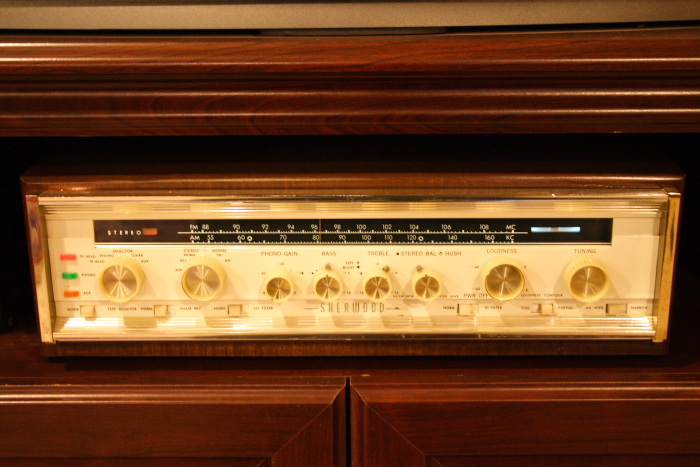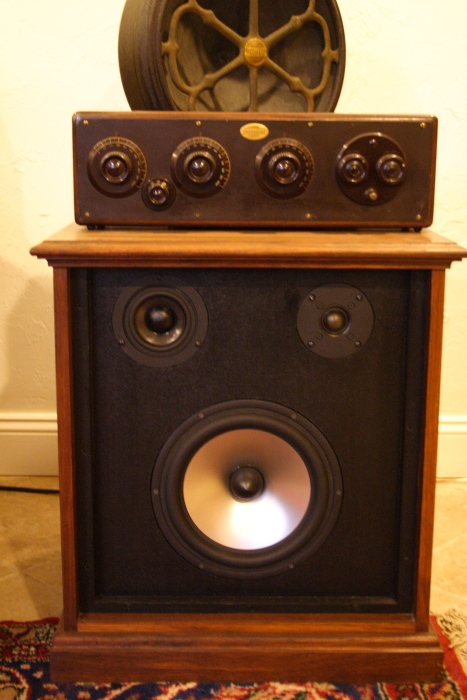My New Hobby - Stereo Receivers
Posts: 2,118
Threads: 112
Joined: Jun 2010
City: Medford OR (OR what?)
Ron, the one I have is tube type. It is a rather rare model with AM. Like many other manufactures at the time, Sherwood was building a lot of receivers with only FM tuners. To be honest , I think it is a S7800, might be a S7900. I play it all the time but look at the name plate almost never. And it is over at the shop, but I will check. In any case it is very similar to this one:
http://s102.photobucket.com/user/roberts...t=4&page=1
Only it also has AM. It has 7868 PP output tubes for about 35-40W per channel. It also has a lot of neat stuff you don't see today like phase reversal and narrow/wide band setting for the AM - like a 1937 Philco.
"I just might turn into smoke, but I feel fine"
http://www.russoldradios.com/
Posts: 1,106
Threads: 88
Joined: Jun 2011
City: Tacoma
State, Province, Country: Washington
Wow! With all that iron, where did they find room for an AM section? 
Loved those reverse polarity switches... saved a lot of time mucking about with speaker wiring.
Posts: 4,327
Threads: 407
Joined: Jun 2011
City: Boston
State, Province, Country: Massachusetts
This is becoming a trend in the electronics restoration community. I see more component stereo stuff at shows and swap meets. It also makes me feel that I am graying, these babies were the "bomb" when I was a teen. I had a friend that worked at Tech Hi Fi that was a Boston legend of sorts.
Paul
Tubetalk1
Posts: 13,776
Threads: 580
Joined: Sep 2005
City: Ferdinand
State, Province, Country: Indiana
Russ, a Sherwood S-7900 is solid state, it's the AM-FM version of the S-8900 which is very similar to the S-8900A I used to own. Unless Sherwood re-used model numbers. 
--
Ron Ramirez
Ferdinand IN
Posts: 2,118
Threads: 112
Joined: Jun 2010
City: Medford OR (OR what?)
This one id the AM/FM version of the s8000, but without pulling it out of the cabinet, that is all I can be sure of.
I'll get a picture of it. Back when I recapped it I had a hard time finding any info on it. A friend gave it to me about 20 years ago. I think they bought it new.
"I just might turn into smoke, but I feel fine"
http://www.russoldradios.com/
Posts: 2,118
Threads: 112
Joined: Jun 2010
City: Medford OR (OR what?)

And to include an old radio:

"I just might turn into smoke, but I feel fine"
http://www.russoldradios.com/
Posts: 13,776
Threads: 580
Joined: Sep 2005
City: Ferdinand
State, Province, Country: Indiana
Neat Sherwood, Russ! 
--
Ron Ramirez
Ferdinand IN
Posts: 244
Threads: 11
Joined: Oct 2011
City: Black Mountain, NC
Cossor 3468
GE 417A
Philco 118H
Radiola 17/100
Scott 800B6
Silvertone 6130
Stromberg 535M
Truetone D1952
Posts: 594
Threads: 41
Joined: Aug 2010
City: Shepherdsville, KY
Hey philcomike
Thanks for posting the link for reading. Lots of memories there. Thanks again.

Joe
Joe Bratcher near Louisville, KY
Posts: 142
Threads: 15
Joined: Nov 2008
City: Glenshaw, PA
PhilcoMike, Yes! I agree with w4rtc, this is one interesting link. Thank you so much. It's incredible the changes to audio performance and electrical circuitry in the 50's and 60's.
Posts: 13,776
Threads: 580
Joined: Sep 2005
City: Ferdinand
State, Province, Country: Indiana
Make that +2. Thanks, Mike! 
Woo hoo, I'm getting a Fisher 600-T on Saturday...one of Fisher's first solid-state receivers...it uses tubes in the FM front end, the rest of it is SS. I'm a happy camper. 
--
Ron Ramirez
Ferdinand IN
Posts: 4,610
Threads: 51
Joined: Sep 2008
City: Sandwick, BC, CA
From what I have heard you need to be careful with a lot of those early solid state tuners, the AM side is usually fine but the germanium transistors in the FM section can become unstable over time. Even the power output ones can become unstable and noisy. In fact the earlier transistors were unreliable at higher frequencies which was likely why Fisher made this set with a tube front end for the FM side and why RCA developed the Nuvistor series of tubes for their TV tuners.
Regards
Arran
Posts: 1,106
Threads: 88
Joined: Jun 2011
City: Tacoma
State, Province, Country: Washington
Germanium transistors almost uniformly suffer from what is called "whisker disease". Crystalline 'whiskers' grow out from the active element, and eventually will contact the outside metal cover of the transistor. This is a problem no matter what, but if whiskers from more than one point reach the cover, it shorts the transistor out. Some brands of transistor have lasted better than others, but so far reports of all brands doing this have been published.
Posts: 15,299
Threads: 531
Joined: Oct 2011
City: Jackson, NJ
I am not aware of anything like it - I used almost exclusively Ge transistors back in the USSR and they are still abundant there and are used in amateur practice and also in most semiconductor portable radios. Not ever saw one transistor going bad due to that kind of things. Overload - yes. Never saw a Ge transistor going bad for internal reason. (actually never saw a Si transistor do that either).
What's more, the power Ge transistors (Soviet П4, П210, П215, П208 and П207) as well as low power ones (MП40 (PNP), МП37 (NPN)) were used extensively by military.
Ge transistors are not without quirks - they work at lower crystal temps (about 85C vs almost 170C for Si), but they do in fact have triple the motility of electrons/holes and the length of run of both charges, as well as half the bandgap.
So Ge devices provide much lower Vf dropouts than the best Si (like Schottky diodes) - 0.3V for diodes vs 0.45-0.5 for the lowest Vf Schottkies (low voltage types).
Ge is more expensive than Si, and Si is convenient. Those were the reasons for ditching Ge transistors. But, in a country like the former USSR they are in such abundance and the prices are so close to junk, they are used extensively and many audiofiles appreciate them for what they can do.
So, "uniformely" in my experience is not even close to the reality.
(This post was last modified: 01-17-2014, 09:12 AM by morzh.)
Posts: 1,106
Threads: 88
Joined: Jun 2011
City: Tacoma
State, Province, Country: Washington
I won't discount your imperical evidence, but it's been enough problems for the electronic industry, not just for Ge transistors, that they have entire think tanks dedicated to mitigation of different forms of 'whisker' mitigation.
For instance:
-INDUSTRY WHISKER CONSORTIA
- CALCE/Military OEM Tin Whisker Forum
- EIA G-12 Committee, "GEB-0002: Reducing the Risk of Tin
Whisker-Induced Failures in Electronic Systems"
- National Electronics Manufacturing Initiative (NEMI)
Accelerated Tin Whisker Test Team
Tin Whisker Modeling Team
Tin Whisker User Group
Users browsing this thread: 1 Guest(s)
|



